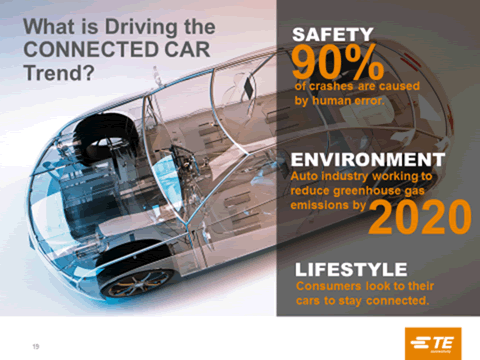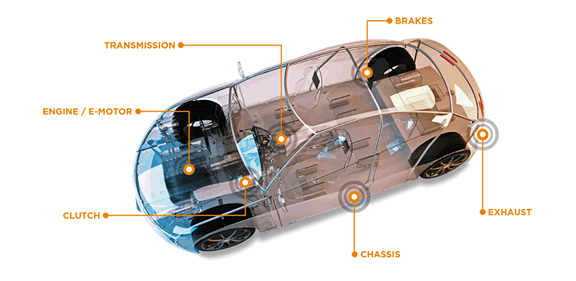The Connected Car: A Revolution in Mobility
Since the modern automobile was invented, its basic functionality and shape has remained essentially the same. However, the environment in which vehicles operate and the data to which they connect are changing dramatically, and components will play a significant role in the automotive revolution.

The connected car has the power to shake up the auto industry as profoundly as the first Model T. The implications for the connected car revolution – and the outlook for its growth – are strongly positive. IHS Automotive predicts that sales of connected cars will grow by six-fold globally through 2020; by that year, says Gartner, 250 million connected vehicles will be on roadways, “making connected cars a major element of the Internet of Things.” But if connected cars – equipped with Internet connectivity and sensor capabilities that can share information with many sources inside and outside the vehicle – are to become as feature-rich and reliable as forecasted, automakers and OEMs must develop the quality connectors and sensors that make connectivity possible.
What is driving the connected car trend? Safety, the environment, and lifestyle changes all play a role.
Safety
Cars, while remarkable inventions, can also be dangerous when driven unsafely. More than one million people die every year in automotive accidents globally. Even though cars have become much safer than they were 50 years ago, their drivers are still a weak link in the safety continuum; research shows that 90% of crashes are caused by human error. US federal agencies that govern automotive safety are recognizing that smarter vehicles can help reduce traffic fatalities and injuries. The New Car Assessment Program, created globally and aligned with the NHTSA, measures collision safety for car occupants, and is now focusing on advanced driver assistance systems (ADAS) technology as a way to manufacture cars that will help drivers better avoid collisions.
Environment
As with safety, automakers, working with government regulators, have made tremendous strides in reducing polluting emissions from cars. The auto industry is currently working to reduce greenhouse gas emissions by 2020, with a focus on vehicle weight, fuel consumption, and improved electrical efficiency. However, inefficient driving habits and traffic congestion are counterproductive to the efforts to make cars more environmentally friendly. A key link between connected cars and greener cars is more efficient routing from point A to point B. When cars are more connected, including to infrastructure, they use less fuel (and pollute less) because there will be less time waiting in traffic (or even non-traffic).
Lifestyle
Consumers who are accustomed to connectivity everywhere they go – at cafes, hotels, home, or office – are reluctant to give up this information access when they are on the road and in their cars. As they build greater connectivity into their homes, they not only expect the same convenience and access in their cars, but they also anticipate their connected homes will sync with their connected cars. These consumers are comfortable with their mobile devices and rely on them to stay connected and access data, and they look to their cars for the same functionality.
OEM Criteria
As automakers shift resources toward technology inside the car, they must focus on all of the market drivers above. This requires a far more complex combination of hardware, software, and connectivity and sensor solutions, such as:
- Robust and reliable connectivity and sensor technologies
- Core connectivity – essential and seamless power, signal, and data
- Reliable performance in harsh environments, such as extreme temperature variations and vibrations in rugged terrain
- Miniaturization – ever smaller, lighter, and modular components
- Effective, safe, and efficient power management
- Faster data transmission, which consumers have come to expect in their connected homes
- Sensing for improved performance and monitoring

Connected for Safety
An increasing level of automation means a growing need for more networking of all onboard systems, as well as sensors. Innovators in this field continue to break ground with technologies that support ADAS, such as:
- Headlamps that help drivers better see the road
- Collision avoidance systems that automatically apply the brakes
- A shift in focus from passive safety to active safety and from warning systems to avoidance systems
- The evolution of parallel parking and chassis control – requiring sensor solutions for fully automated control
Connected for Safety
As consumers push for the availability of real-time data in their cars, carmakers and technology providers need to guarantee data speeds and availability. For example, vehicles must respond immediately when a signal is transmitted that requires a response. Systems cannot suffer resets or delays – reaction time must be in a fraction of a second. Connected car systems must be capable of transmitting a full gigabyte of information per second under high-vibration conditions if they are to be considered reliable. To contribute to safety, connected cars must also share supplementary information from WLAN or mobile telecommunication channels between the onboard electronic devices and the infrastructure (V2I) or other vehicles in the vicinity (V2V), which will boost the decision confidence level of the ADAS.
Connected for Green
Regulators and scientists agree: If we are committed to improving air quality, we must improve driving efficiency. This means innovating ways to reduce the time cars are on the road and also requiring less fuel for effective operation. Environmentally friendly driving can be a result of advanced manufacturing techniques. A vehicle’s weight can be reduced by using lighter or less material, thus improving fuel efficiency and therefore reducing C02 emissions. One tactic for using less material in a vehicle is to miniaturize its components. In addition, the use of aluminum and connectivity solutions in vehicles can reduce weight. As automakers go lighter, they must give extra consideration to areas of the vehicle such as the body, drive systems, chassis, and on-board electrical systems. Higher temperatures and vibrational loads require improved and innovative terminal and connector systems.
Connected for Lifestyle
To bring car owners the features and functions that optimize driver comfort, improve navigation and guidance, and deliver entertainment, automakers must work with technology vendors to create in-dashboard applications that supply drivers and passengers with cloud-connected information and services. These systems often are referred to as “telematics” and provide two-way communications to the vehicle and from the vehicle.
These lifestyle and convenience features not only keep car occupants better informed and entertained, they can help boost productivity. When connected cars eventually make the leap to self-driving vehicles, drivers can become more productive, using the time spent in the car for something other than paying attention to traffic conditions. In addition, if improved traffic management technologies reduce time spent in the car, drivers and passengers gain more time for other activities.
Potential Roadblocks
While the technologies and capabilities are in place (and are evolving) to deliver on the connected car in the future, other factors must be addressed in this ecosystem:
- Security and privacy – The exchange of data among applications in the vehicle and other systems, such as over Wi-Fi and to connected home systems, raises issues about how this data is protected.
- Internet access – There is currently a limitation as liability for accessing data across geographies is not clarified and various countries have different regulations.
- Infrastructure – Building safer and more fuel-efficient vehicles means little if roadways deteriorate. Traffic management efforts must take roadway investments into account.
- Autonomous driving buy-in – To embrace the idea of self-driving cars, consumers need assurance that they are safer than driving the cars themselves. Automakers must demonstrate proof that autonomous vehicles operate with near 100% reliability.
- Economics – Connected car advances must make good economic sense for car buyers, or connected cars will be seen as a luxury innovation available to only a select few. Connectivity should be affordable – industry standard components will further the affordability cause.
To read this white paper in its entirety, click here.




